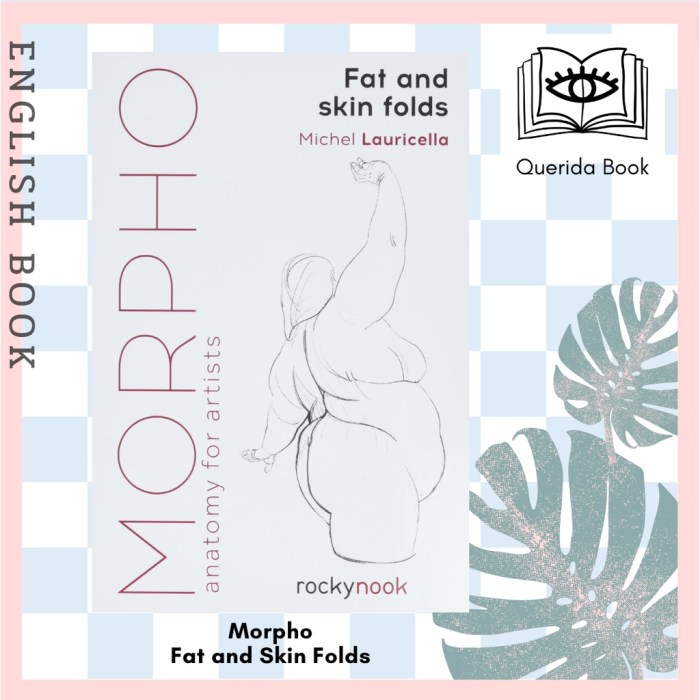Ever wonder how artists make their figures look so real? It’s all about the details, and one of the most crucial elements is understanding the anatomy of fat and skin folds. From the subtle curves of a bicep to the way a belly hangs, these details make all the difference in creating believable characters.
This guide, “Morpho Fat and Skin Folds Anatomy for Artists,” dives deep into the world of human anatomy, focusing specifically on the role of fat and skin folds in creating realistic figures. We’ll explore how fat distribution and skin fold formation vary across different body types and ethnicities, and we’ll break down the anatomical details of these folds, including their names, locations, and associated muscles and bones.
Get ready to level up your art game with this in-depth look at the anatomy of fat and skin folds!
Morphoanatomy of Fat and Skin Folds
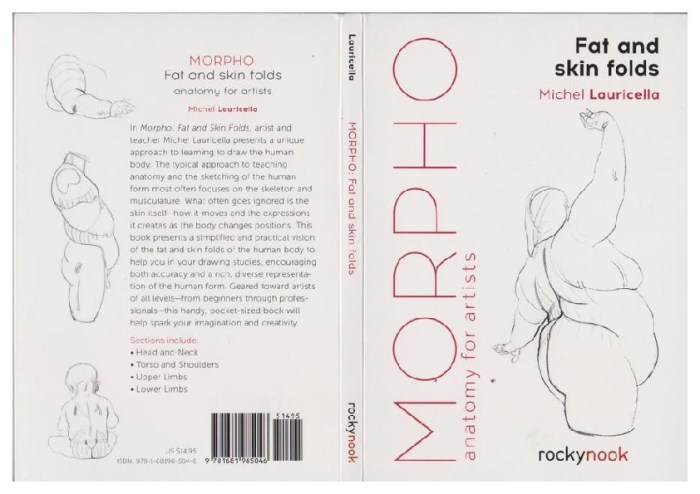
It’s time to dive into the world of bumps and curves! This chapter explores the fascinating relationship between fat, skin folds, and the overall shape of the human body. Understanding how fat distribution and skin fold formation affect the body’s contours is key to creating realistic and expressive figures.
Think of it as unlocking the secrets of the “soft” anatomy, which plays a huge role in defining character and personality in your art.
Subcutaneous Fat Distribution and Function
Subcutaneous fat, that layer of padding beneath the skin, is more than just a cushion. It’s a major player in shaping the body’s contours and influencing the formation of skin folds. It’s like the “marshmallow layer” that gives the body its rounded forms and defines the way the skin drapes over the underlying muscles and bones.
This fat distribution isn’t uniform; it varies across the body, influenced by factors like genetics, age, and lifestyle.
- Fat Distribution:Fat isn’t distributed evenly. Think of it like a map with different “fat zones.” Areas like the hips, thighs, and abdomen tend to store more fat compared to areas like the face, hands, and feet. These differences in fat distribution create the characteristic curves and bulges of the human form.
- Skin Folds:Fat deposits influence how the skin drapes and folds. Areas with thicker fat layers will exhibit more prominent skin folds, while areas with thinner fat layers will have smoother transitions. This interplay between fat and skin creates the unique folds and creases that give the body its individual character.
- Function:Subcutaneous fat isn’t just about looks. It serves several vital functions, including:
- Insulation:It acts as a thermal insulator, keeping us warm in cold environments.
- Energy Storage:It stores energy for the body, providing a backup fuel source when needed.
- Protection:It cushions and protects underlying organs and tissues from injury.
Variations in Fat Distribution and Skin Folds
The distribution of fat and the formation of skin folds vary significantly across different body types and ethnicities. It’s like having a diverse collection of “body blueprints” with unique fat and skin fold patterns.
- Body Types:Different body types exhibit distinct fat distribution patterns. Think of the classic “apple,” “pear,” and “hourglass” shapes. Each body type has its own characteristic fat storage areas and corresponding skin fold formations. For example, the “pear” shape typically has more fat stored in the lower body, leading to more prominent folds in the hips and thighs.
- Ethnicities:Ethnicities also play a role in fat distribution and skin fold formation. For example, certain ethnicities may have a tendency to store fat in specific areas, leading to characteristic skin fold patterns. Understanding these variations is crucial for creating diverse and accurate representations of human figures in art.
Major Skin Folds
Now let’s get into the nitty-gritty details of those folds. Understanding their anatomy is key to drawing realistic and expressive figures.
- Neck:The neck is a prime example of how fat and skin folds work together.
- Submental Fold:This fold, also known as the “double chin,” is a classic example of how fat deposits can create prominent folds. It’s formed by the accumulation of fat under the chin, which causes the skin to fold over itself.
- Lateral Neck Folds:These folds, also known as “neck lines,” run along the sides of the neck, from the ear to the shoulder. They’re formed by the movement of the neck muscles and the way the skin drapes over them. They can be accentuated by fat deposits, making them more prominent.
- Torso:The torso is a region with several prominent folds, particularly in areas where the skin is stretched over bony prominences.
- Axillary Folds:These folds, located under the arms, are formed by the way the skin drapes over the shoulder joint and the underlying muscles.
They can be quite pronounced, especially in individuals with more fat in the upper body.
- Breast Folds:The breast is a complex structure with its own unique folds. The folds under the breast, known as the inframammary fold, are formed by the way the skin drapes over the breast tissue and the underlying muscles. The shape and prominence of these folds can vary greatly depending on breast size and fat distribution.
- Abdominal Folds:The abdomen is another area where fat deposits can create prominent folds. The umbilical foldis a vertical fold that runs from the sternum to the pubis, while the lateral abdominal foldsare horizontal folds that run along the sides of the abdomen. These folds can be more pronounced in individuals with a higher body mass index (BMI).
- Axillary Folds:These folds, located under the arms, are formed by the way the skin drapes over the shoulder joint and the underlying muscles.
- Limbs:The limbs also have their own set of folds, formed by the way the skin drapes over the muscles and bones.
- Elbow Folds:The elbow is a common area for skin folds, especially when the arm is bent. The antecubital foldis the fold that runs across the front of the elbow, while the posterior elbow foldis the fold that runs across the back of the elbow.
- Knee Folds:The knee is another area with prominent folds, particularly when the leg is bent. The popliteal foldis the fold that runs across the back of the knee, while the anterior knee foldis the fold that runs across the front of the knee.
- Ankle Folds:The ankle is a common area for skin folds, especially when the foot is flexed. The medial malleolar foldis the fold that runs along the inside of the ankle, while the lateral malleolar foldis the fold that runs along the outside of the ankle.
Utilizing Knowledge of Fat and Skin Folds in Art
Now that you’ve got a handle on the anatomy of fat and skin folds, it’s time to put that knowledge to work! Understanding these structures can elevate your artwork to a whole new level of realism and expressiveness.
So, you’re all about nailing that realistic look for your art, right? You’re studying up on how fat and skin folds work, and you’re ready to level up your game. But sometimes, even the most dedicated artist needs a little break.
That’s where the Vogue Fashion Coloring Book comes in. It’s like a chill session for your creative mind, filled with cool fashion illustrations that are just waiting to be brought to life. Then, when you’re ready to get back to the anatomy grind, you’ll be refreshed and ready to tackle those tricky folds with even more confidence.
- Realistic Figures:Accurately representing fat and skin folds adds depth and believability to your figures. Think of it as adding the finishing touches to a sculpture, giving it that “lifelike” quality.
- Character Expression:Fat and skin folds can be used to subtly convey character traits. For example, a figure with prominent folds in the neck and abdomen might suggest a more mature or weathered character. Conversely, a figure with smoother skin and fewer folds might convey youthfulness or athleticism.
- Dynamic Poses:Understanding how fat and skin folds shift with movement can help you create more dynamic and believable poses. Think about how folds bunch up and stretch as a figure bends, twists, or stretches. These subtle details add a level of realism and dynamism to your art.
So, you’re digging into the nitty-gritty of how fat and skin folds work on the human body? That’s some serious dedication to your art, dude! Maybe you need a little break from all that anatomy, though. Check out this Ennio Morricone Piano Sheet Music Piano Solo to chill out for a bit.
It’s like a soundtrack for your inner artist, you know? Once you’re back in the zone, you’ll be nailing those anatomical details like a pro.
Illustrative Techniques for Depicting Fat and Skin Folds
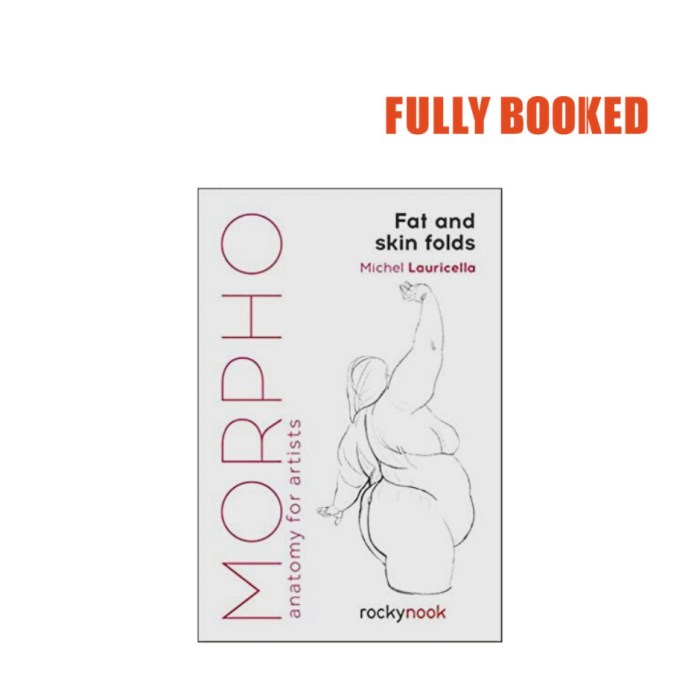
Now that you’ve got a handle on the anatomy of fat and skin folds, it’s time to bring those juicy bits to life on paper (or screen!). We’re gonna dive into some killer techniques that’ll help you capture the beauty and complexity of these folds in your art.
Line Drawing Techniques for Depicting Fat and Skin Folds
Line drawing is like the foundation of any good art piece, and it’s super important for understanding the shape and structure of fat and skin folds. Think of it as building a skeleton for your folds.
- Contour Lines:These are the lines that define the outer edge of the fold. They can be smooth or jagged, depending on the type of fold. For example, a soft fold might have a smooth contour line, while a sharper fold might have a more jagged contour line.
- Internal Lines:These lines show the internal structure of the fold, like the way the skin folds over itself or the way fat pushes against the skin. Internal lines can be used to create a sense of depth and volume.
- Hatching and Cross-Hatching:These techniques use parallel lines to create shading and texture. They’re especially useful for depicting the subtle variations in the surface of the skin, like the way light hits a fold and creates shadows. Think of hatching as a way to build up layers of tone and texture.
Shading Techniques for Depicting Fat and Skin Folds
Shading is where the magic really happens! It’s how you bring your folds to life and give them dimension. There are tons of ways to shade, but here are a few key techniques to get you started.
- Chiaroscuro:This technique uses strong contrasts between light and dark to create a sense of volume and depth. Think of it like using a spotlight to highlight the folds and create dramatic shadows. Chiaroscuro is a great way to show the way light bounces off the curves of the body.
- Soft Shading:This technique uses gradual transitions between light and dark to create a smooth, subtle effect. It’s perfect for depicting the soft, rounded shapes of fat and skin folds. Think of it as a gentle caress of light and shadow.
- Highlighting:Adding highlights to your folds is like putting the finishing touches on a masterpiece. They create a sense of luminosity and make your folds pop off the page. Think of them as the sun’s kiss on your artwork.
Color Techniques for Depicting Fat and Skin Folds
Color is the ultimate way to bring your fat and skin folds to life. It can be used to create realistic skin tones, highlight the texture of the skin, and even create a sense of mood or emotion.
- Skin Tones:Using a range of colors, from warm browns to cool pinks, can create realistic skin tones. You can also use color to depict the subtle variations in skin tone that occur due to the presence of fat and skin folds.
- Color Temperature:The temperature of your colors can influence the overall mood of your artwork. For example, warm colors like reds and yellows can create a sense of warmth and energy, while cool colors like blues and greens can create a sense of calmness and serenity.
Experiment with color temperature to see how it affects the appearance of your folds.
- Color Saturation:The saturation of your colors can also affect the appearance of your folds. Highly saturated colors can create a sense of vibrancy and energy, while desaturated colors can create a sense of subtlety and realism. Experiment with different levels of saturation to find what works best for your artwork.
Artistic Mediums for Depicting Fat and Skin Folds
The choice of artistic medium can significantly impact how you depict fat and skin folds. Here’s a breakdown of different mediums and their suitability for rendering these details.
| Medium | Suitability for Fat and Skin Folds | Advantages | Disadvantages |
|---|---|---|---|
| Pencil | High | Versatile, easy to blend, allows for subtle detail | Can be messy, smudges easily |
| Charcoal | High | Creates rich blacks and deep shadows, excellent for texture | Can be messy, difficult to erase |
| Ink | Medium | Sharp lines, clean and precise, great for detail | Less forgiving, difficult to blend |
| Oil Paint | High | Allows for rich layering, creates depth and texture | Can be time-consuming, requires specialized materials |
| Watercolor | Medium | Allows for soft transitions, creates ethereal effects | Can be difficult to control, requires careful layering |
| Digital Painting | High | Highly versatile, easy to edit and experiment | Can be less tactile, requires digital tools |
Step-by-Step Guide to Drawing a Figure with Realistic Fat and Skin Folds
Ready to put your new knowledge to the test? Let’s create a figure with realistic fat and skin folds! Here’s a step-by-step guide to get you started.
- Start with a basic sketch:Begin with a simple Artikel of the figure, paying attention to the overall proportions and pose. Don’t worry about details just yet. This is just a starting point.
- Add the fat and skin folds:Using your knowledge of anatomy, start to add the fat and skin folds to your sketch. Think about the way the fat and skin drape over the body, and how they are affected by the pose. Use contour lines and internal lines to define the shape of the folds.
- Shade the folds:Using shading techniques, start to add depth and volume to your folds. Think about where the light hits the folds, and how it creates shadows and highlights. You can use hatching, cross-hatching, or soft shading to create different effects.
- Add color:If you’re working in color, use a range of skin tones to create a realistic effect. Consider using color temperature and saturation to add depth and interest to your folds.
- Refine and polish:Take your time to refine your drawing, paying attention to detail. Add highlights, shadows, and texture to create a sense of realism and depth.
Impact of Lighting on Fat and Skin Folds
Lighting plays a huge role in how fat and skin folds appear. The direction, intensity, and color of the light can all affect the way folds cast shadows, create highlights, and influence the overall mood of your artwork.
Imagine a figure standing in the harsh sunlight. The folds will cast sharp, defined shadows, creating a sense of depth and contrast. Now imagine the same figure standing in soft, diffused light. The folds will cast softer shadows, creating a more gentle and subtle effect.
The color of the light can also affect the appearance of the folds. Warm light, like the light of the setting sun, can create a sense of warmth and vibrancy. Cool light, like the light of a cloudy day, can create a sense of coolness and serenity.
Applications in Artistic Practice
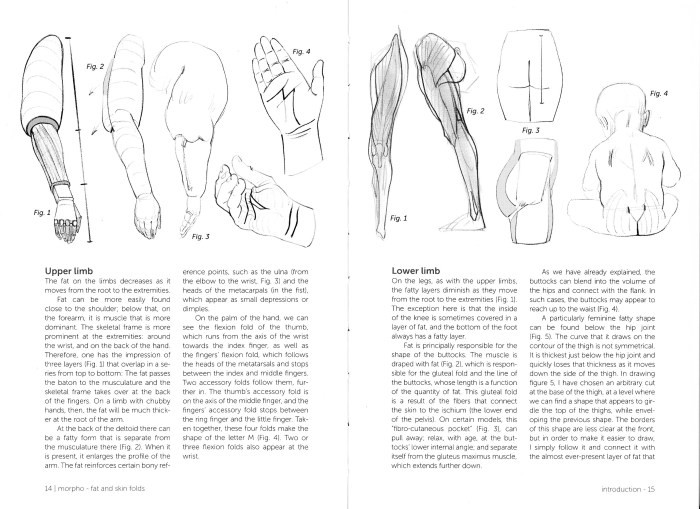
Understanding the anatomy of fat and skin folds can elevate your art from basic to breathtaking. It’s not just about drawing wrinkles, it’s about capturing the essence of form, movement, and even emotion. This knowledge can transform your character design, costume design, and portraiture, creating characters that feel real and relatable.
Impact on Character Design
The way fat and skin folds drape and move reveals a character’s personality and backstory. Think about it: a character who is constantly on the move, like an athlete, will have different folds than a character who spends most of their time sitting, like a scholar.
These details add depth and believability to your creations.
- Body Type and Personality:A character with a more rounded physique might be portrayed as jovial, nurturing, or even powerful, while a lean character might be perceived as agile, quick-witted, or even ruthless. By understanding how fat distribution affects the body’s form, artists can create characters that visually communicate their personalities.
Think about how the folds around a character’s neck or stomach can convey a sense of comfort, tension, or even vulnerability.
- Age and Life Experience:The presence and distribution of fat and skin folds can also communicate a character’s age and life experience. A character with deep wrinkles and sagging skin might be perceived as wise and experienced, while a character with smooth skin and fewer folds might be seen as young and energetic.
Learning about the intricacies of fat and skin folds in “Morpho Anatomy for Artists 4” can feel like deciphering a whole new language. But hey, sometimes the best way to unlock new knowledge is through a fun, hands-on approach. Just like learning to play the ukulele with “Ukulele for Kids How to Play the Ukulele with 45 Songs.
First Book + Audio and Video” Ukulele for Kids How to Play the Ukulele with 45 Songs. First Book + Audio and Video , “Morpho Anatomy for Artists 4” can be a super cool way to boost your artistic skills, whether you’re a total newbie or a seasoned pro.
Artists can use these details to create characters that are visually compelling and relatable, regardless of their age.
- Character Movement and Interaction:Fat and skin folds move in different ways depending on the character’s actions. A character who is running will have different folds than a character who is sitting down. Artists can use this knowledge to create dynamic and believable character animation.
For example, a character who is carrying a heavy object will have more pronounced folds around their shoulders and back, while a character who is dancing will have more fluid and graceful movements.
Depiction of Fat and Skin Folds in Different Artistic Styles
The way fat and skin folds are depicted can vary greatly depending on the artistic style.
- Realism:Realist artists aim to capture the human form as accurately as possible, paying close attention to the details of fat and skin folds. This style often involves detailed rendering of individual folds, their textures, and their subtle variations.
Think about the work of Michelangelo, who meticulously depicted the musculature and skin folds of the human body in his sculptures. His works, like the David, exemplify how realistic depictions of fat and skin folds can contribute to a sense of realism and grandeur.
- Impressionism:Impressionist artists, on the other hand, focused on capturing the fleeting effects of light and color, using loose brushstrokes and simplified forms. Fat and skin folds might be suggested rather than precisely rendered, contributing to a sense of movement and energy.
Want to level up your art game and make your characters look totally realistic? “Morpho Fat and Skin Folds Anatomy for Artists (Morpho Anatomy for Artists 4)” is the ultimate guide to nailing those details, and you can Download And Listen Here to get started.
This book breaks down everything from the science of fat distribution to the nuances of skin folds, so you can create characters that look like they could step right out of the screen.
Consider the works of Claude Monet, whose paintings often feature figures with loose, suggestive brushstrokes that capture the fleeting beauty of light and color. While these brushstrokes may not depict fat and skin folds with the same level of detail as realism, they still convey a sense of form and movement.
- Abstract Art:Abstract artists often focus on expressing emotions and ideas through non-representational forms. Fat and skin folds might be represented through abstract shapes, lines, and textures, contributing to a sense of dynamism and expressiveness. Consider the works of Willem de Kooning, whose abstract paintings often feature gestural brushstrokes that evoke a sense of energy and movement.
These brushstrokes can be interpreted as representing fat and skin folds, even though they are not explicitly depicted in a realistic way.
Artists Who Excelled in Depicting Fat and Skin Folds
Throughout history, many artists have excelled in depicting fat and skin folds. Their work provides inspiration and valuable insights into the nuances of human anatomy.
- Michelangelo:As mentioned earlier, Michelangelo’s sculptures are renowned for their meticulous depiction of the human form, including the subtle details of fat and skin folds. His works, like the David and the Pietà, demonstrate how a deep understanding of anatomy can contribute to a sense of realism and grandeur.
Michelangelo’s ability to render the complex interplay of muscle, fat, and skin folds is truly remarkable.
- Rembrandt van Rijn:Rembrandt was a master of light and shadow, and he used this skill to create dramatic and expressive portraits. His paintings often feature figures with deep wrinkles and folds, which are rendered with remarkable detail and sensitivity. His portraits, like the “Self-Portrait with a Shawl,” showcase how the interplay of light and shadow can accentuate the texture and depth of fat and skin folds, adding a sense of realism and emotion to his work.
- Edgar Degas:Degas was a renowned painter and sculptor who was particularly interested in capturing the human form in motion. His paintings often feature dancers, athletes, and other figures in dynamic poses, and he paid close attention to the way fat and skin folds move and drape.
His works, like “La Classe de Danse,” exemplify how the depiction of fat and skin folds can contribute to a sense of movement and dynamism.
Impact on Animation, Illustration, and Sculpture
The knowledge of fat and skin folds is crucial for creating believable and engaging characters in animation, illustration, and sculpture. This understanding allows artists to create characters that move realistically and interact with their environment in a believable way.
- Animation:In animation, the way fat and skin folds move can affect a character’s overall appearance and how they are perceived by the audience. For example, a character with more pronounced folds might be seen as more grounded and relatable, while a character with fewer folds might be seen as more agile and energetic.
Animators can use this knowledge to create characters that are visually appealing and believable, regardless of their body type.
- Illustration:Illustrators can use their knowledge of fat and skin folds to create characters that are both visually appealing and emotionally resonant. By understanding how fat distribution affects the body’s form, illustrators can create characters that feel real and relatable, regardless of their age or body type.
For example, an illustrator who is creating a character with a more rounded physique might pay close attention to the way fat folds around the character’s neck, stomach, and arms, adding a sense of comfort and warmth to the character’s appearance.
- Sculpture:Sculptors can use their knowledge of fat and skin folds to create sculptures that are both anatomically accurate and aesthetically pleasing. By understanding how fat and skin folds interact with muscle and bone, sculptors can create sculptures that are both realistic and expressive.
For example, a sculptor who is creating a bust of a person might pay close attention to the way fat folds around the neck and shoulders, adding a sense of realism and individuality to the sculpture.
Book Review
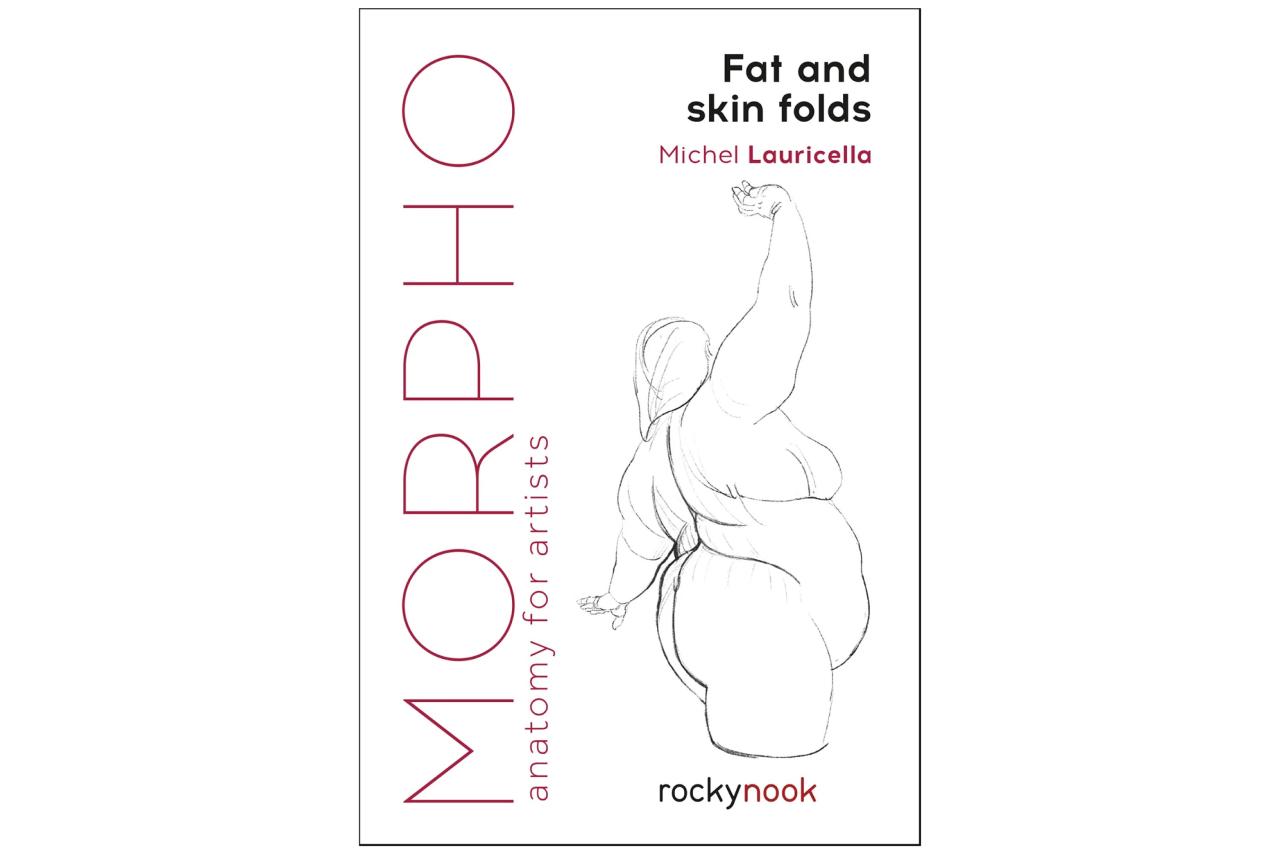
Yo, fellow artists! Let’s talk about “Morpho Anatomy for Artists 4: Fat and Skin Folds,” the latest installment in the epic “Morpho Anatomy” series. This book dives deep into the anatomy of fat and skin folds, a topic that’s often overlooked but crucial for creating realistic and believable figures.
Target Audience and Accessibility
This book is aimed at artists of all levels, from beginners to seasoned professionals. It’s written in a clear and engaging style, with tons of illustrations and diagrams that break down complex anatomical concepts. Even if you’re not a anatomy whiz, you’ll be able to grasp the key concepts and apply them to your art.
Strengths and Weaknesses
“Morpho Anatomy for Artists 4” is a total game-changer for understanding how fat and skin folds work. Here’s the lowdown:
Strengths
- Detailed Anatomical Illustrations:The book is packed with high-quality illustrations that show the intricate structure of fat and skin folds. These visuals are super helpful for understanding how these structures interact and how they affect the overall form of the body.
- Clear and Concise Explanations:The text is written in a way that’s easy to understand, even for those who are new to anatomy. The author does a great job of breaking down complex concepts into manageable chunks.
- Practical Applications:The book doesn’t just focus on theory; it also provides practical tips and techniques for applying your knowledge of fat and skin folds to your artwork. This makes the book incredibly valuable for artists who want to improve their figure drawing skills.
Weaknesses
- Limited Coverage of Diversity:While the book does a good job of illustrating a range of body types, it could benefit from more representation of diverse body shapes and sizes. This would make the book more inclusive and relevant to a wider audience.
- Focus on Western Anatomy:The book primarily focuses on Western anatomical structures. While this is a good starting point, it would be great to see more information on the anatomical variations found in different cultures and ethnicities.
Comparison to Other Resources
Compared to other resources on fat and skin fold anatomy, “Morpho Anatomy for Artists 4” stands out for its detailed illustrations and clear explanations. It’s a great complement to other books and tutorials on figure drawing. However, it’s important to note that the book’s focus on Western anatomy might limit its applicability to artists working with diverse subjects.
Overall Value
Overall, “Morpho Anatomy for Artists 4” is a valuable resource for any artist who wants to improve their understanding of human anatomy and its application in their work. It’s a must-have for artists who want to create more realistic and believable figures, especially those who are struggling with depicting fat and skin folds.
While the book has some limitations, its strengths outweigh its weaknesses, making it a worthwhile investment for serious artists.
Last Point
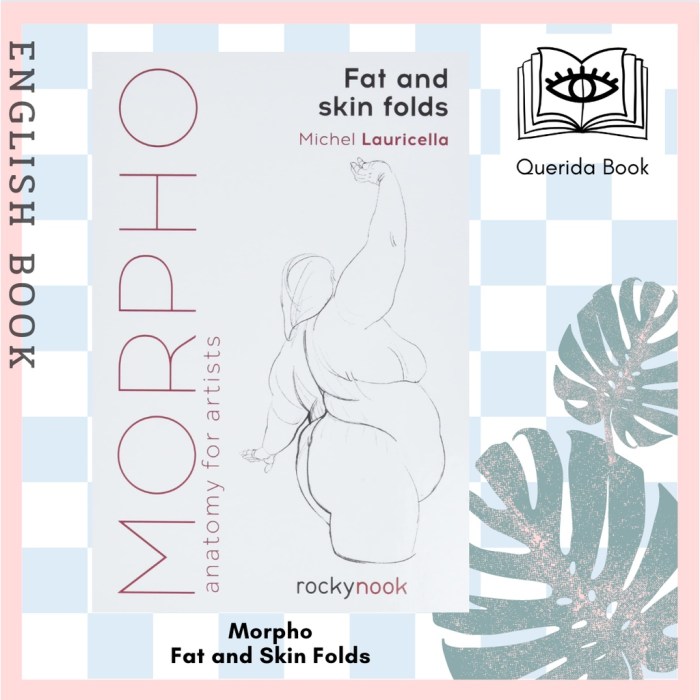
Mastering the art of depicting fat and skin folds is a game-changer for artists. By understanding the anatomy and applying the right techniques, you can create figures that are not only realistic but also express a wide range of emotions and stories.
So, grab your pencils, brushes, or sculpting tools, and get ready to unleash your inner Michelangelo with the knowledge you’ve gained from “Morpho Fat and Skin Folds Anatomy for Artists.” It’s time to sculpt, draw, and paint with the confidence of a pro!
FAQ
What are some common mistakes artists make when drawing fat and skin folds?
One common mistake is drawing folds that are too sharp or too deep. Remember, fat and skin folds are generally soft and rounded. Another mistake is not considering the underlying muscle structure, which influences how the fat and skin fold.
What are some good resources for learning more about fat and skin fold anatomy?
In addition to “Morpho Anatomy for Artists 4,” there are many other great resources available. Check out books on anatomical drawing, online tutorials, and even anatomical reference apps. Remember, practice makes perfect, so don’t be afraid to experiment and find what works best for you.

